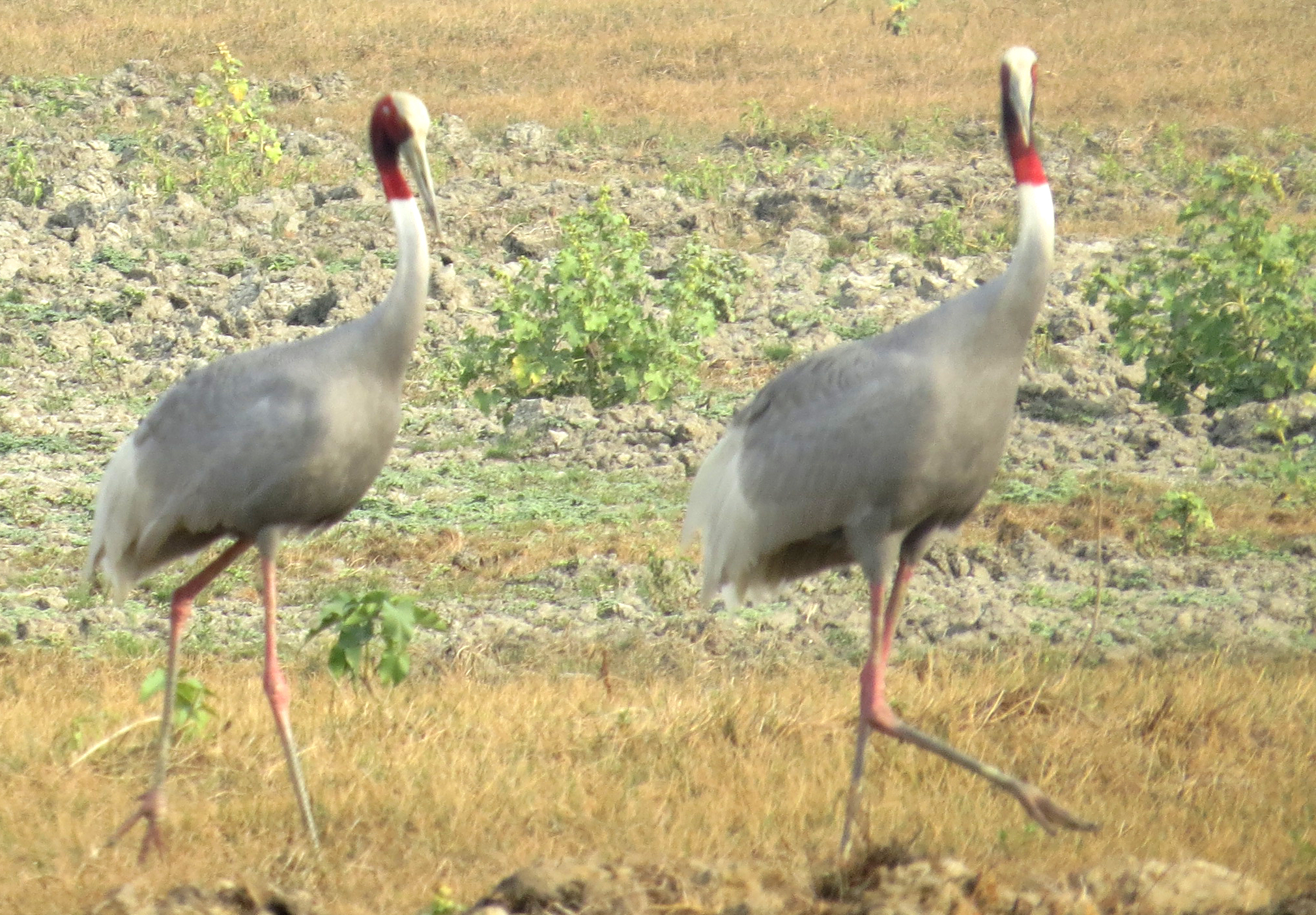
S O S: SAVE OUR SARUS
S O S: SAVE OUR SARUS
If I had been the Quizmaste, I would have posed three questions to the participants; “What is the State Animal of Uttar Pradesh?”, “What is the State Bird of Uttar Pradesh?” and, “Why?” While I would have awarded special prizes to those who would have answered the first two questions correctly; I would have declared that person the winner who would have answered the final question appropriately.
Now people might ask what is so special about these questions! Well! These three questions summarize the Environmental and Wildlife issues/problems that besiege Uttar Pradesh. Before I explain at length, I would like to answer the first two questions. Some readers would be wondering that while they have heard about the National animal and bird, is there something like the State animal/ bird? There is such a thing and it is a matter of regret that people are not aware of them. The Barasingha (the Swamp Deer) is our state animal and the Sarus Crane our state bird.
And so we arrive at the final question, why has this (rather unknown) status been awarded to these handsome creatures. Obviously they are found in U.P. But they are not confined to U.P alone. The correct answer is that both the Barasingha and the Sarus are residents of a Wetland. Uttar Pradesh happens to be a natural wetland. The reader must be thinking, U.P is famous as a Badland and Politic-land, but what is this wetland?
A Wetland is, in a very simple language, a land saturated by water for a certain period of time. It is a unique Eco-System that sustains a very rich bio-diversity: plants, insects, birds and animals. As the word ‘Wet” implies, this eco-system is associated with water. River banks, jheels, lakes, ponds, marshlands, swamps, all of these are Wetlands. Uttar Pradesh is a low lying plain; hundreds of mighty and humble rivers flow here. Our state is thus a unique creation of Mother Nature; a Natural Wetland Paradise; an agricultural power house; a repository of bio-diversity. No wonder 600 of the 1200 species of Indian birds are found in Uttar Pradesh. A wetland is the habitat of the Sarus Cranes. This is the only place where the Sarus resides and thrives.
The Sarus cranes have remarkably human qualities; and genteel qualities at that. They stand tall at an average height of 160 c.m. They are handsome. And the romantics opine that they pair for life. They nurture their fledgling zealously, till he is equipped to face the challenges of an adult life. But it is their ritual mating dance that reminds one of the salons of the 18th Century France. The pairs spread their wings, they bow, they prance and leap and their deep calls resonate in the stillness of the countryside. Their flight is both interesting and amusing. The Sarus initiates its flight with a clumsy run on the ground to gain momentum. It seems the poor bird was not designed for the sky. But a few moments later, the Sarus stretches its wings and utilizing the air currents, soars in the air like an adept aviator always accompanied by his inseparable co-pilot.
Field studies on the Sarus cranes have been conducted by K.S. Gopi Sundar and B.C. Chaudhary of the Wildlife Institute of India at Dehradun. Their research has more shed light on the Sarus, especially in view of their declining numbers. This would strike like a bolt from the blue for the older generation. Gone are the days when Sarus were a common sight! The Sarus is presently classified as globally threatened species. Just around 9000 birds exist world wide. The birds are highly vulnerable because the wetlands are being drained for agriculture.
Though the Sarus cranes are revered in the Hindu tradition and not poached upon, the habitat of the Sarus is shrinking. The reason is the insatiable human greed. Our wonderful wetlands are being encroached upon with impunity. The revenue authorities, the farmers, villagers and builders do not look upon wetlands as aquifers and sanctuaries of bio-diversity; but merely as a commodity to be exploited. The wetlands are thus being converted into fields and residential areas. And while man has raised his obnoxious and ugly concrete structures (for e.g. in Gomtinagar and Ashiana), the poor Sarus has nowhere to go. Its population is thus dwindling. International agencies like the World Bank is also played a dubious role in the disappearance of our wetlands. They have convinced us that our Environmental Consciousness is the reason for our poverty and so they are pumping billions for the Sodic Land Reclamation Project of the U.P Government. This project aims to ‘reclaim’ wetlands for agriculture. These great economists refer our wetlands as wasteland. Fortunately the indefatigable conservation campaign of organizations like the Wildlife Trust of India and the Judicial activism has halted the juggernaut of such ecologically disastrous projects in the Etawah-Maipuri belt. This region is home to the largest concentration of the Sarus cranes in the world. . On the existence of the Wetlands depends the survival of the Sarus. Is there hope for the Sarus then?
Karavan Heritage and Nature Society would like to appeal to all concerned and considerate people to inform us about any sightings of these magnificent birds. Any information would immensely help in the conservation of the Sarus Cranes.
Sarus is the emblem of the natural heritage of U.P because it represents our beautiful wetlands. The sheer beauty and elegance of the Sarus has mesmerized me, though I find it very odd to consider a certain bird as most beautiful or colorful. It must be Einsteinian Relativity that hours drift by unknown, when armed with a just a pair of binoculars, crouching behind a thorny bush, I watch the lively antics of a Sarus family (a male, a female and their young). Much have I heard and dabbled somewhat with much that lies between science and spirituality, but nothing has brought me greater joy than watching the birds of the wetland in some obscure village of U.P.

